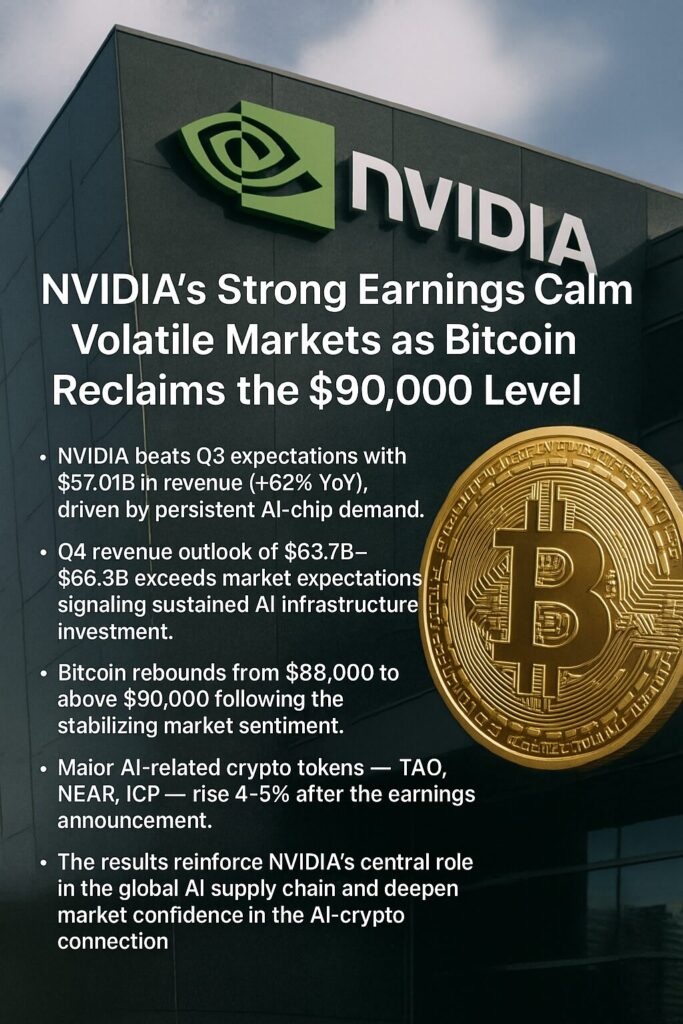
Main Points :
- NVIDIA beats Q3 expectations with $57.01B in revenue (+62% YoY), driven by persistent AI-chip demand.
- Q4 revenue outlook of $63.7B–$66.3B exceeds market expectations, signaling sustained AI infrastructure investment.
- Bitcoin rebounds from $88,000 to above $90,000 following the stabilizing market sentiment.
- Major AI-related crypto tokens — TAO, NEAR, ICP — rise 4–5% after the earnings announcement.
- The results reinforce NVIDIA’s central role in the global AI supply chain and deepen market confidence in the AI-crypto connection.
Introduction — NVIDIA’s Earnings Restore Market Confidence
NVIDIA’s latest earnings report landed at a critical moment for global financial markets. The broader macro environment has been unstable, with investors balancing concerns over fluctuating interest-rate expectations, geopolitical tensions, and the rapid expansion of AI-related investments. In this environment, NVIDIA’s strong Q3 results and above-market Q4 guidance acted as a stabilizing force, calming volatility across equities and crypto markets.
Bitcoin, which briefly dipped to $88,000, quickly rebounded into the $90,000 range as market sentiment improved. For investors in digital assets — particularly those exploring new altcoins, emerging AI-crypto ecosystems, and real-world blockchain applications — NVIDIA’s performance provides two important signals:
- AI infrastructure demand is not slowing.
- Crypto assets linked to AI computation or decentralized machine-learning networks may benefit from structural growth.
This article analyzes NVIDIA’s results, the reaction of crypto markets, and what this means for future blockchain-AI investment strategies.
1 — NVIDIA’s Q3 Results: A Breakdown of Performance
NVIDIA reported $57.01B in Q3 revenue, a remarkable 62% year-over-year increase, significantly above Wall Street expectations. The company’s data center revenue alone hit $51.2B, underscoring the dominance of AI-driven compute demand.
Key factors driving the quarter:
1. Exponential AI Workload Growth
CEO Jensen Huang highlighted that both training and inference workloads are expanding “exponentially,” supported by accelerating deployments of large-scale language models, multimodal AI systems, and enterprise-grade machine-learning pipelines.
2. Blackwell GPUs Selling Out
Huang stated that demand for the new generation of Blackwell architecture GPUs has vastly exceeded supply. Cloud providers, sovereign AI programs, and enterprise AI platforms continue to absorb increasing volumes of GPU resources.
3. Strong Q4 Guidance Boosts Investor Confidence
NVIDIA projected $63.7B–$66.3B in revenue for the next quarter — well above the market consensus of ~$62B. The guidance suggests that AI infrastructure spending remains at historic highs and is expected to continue well into 2026.

The chart illustrates NVIDIA’s Q3 performance, its data-center revenue, and the midpoint of its Q4 revenue forecast.
2 — Bitcoin Rebounds Above $90,000
Following the earnings release, Bitcoin climbed strongly back into the $90,000 range. The recovery occurred after BTC nearly fell to $88,000 earlier in the day, highlighting how sensitive crypto markets remain to macro-tech sentiment.
Three main dynamics explain the rebound:
1. AI Spending = Tech Market Stability = Bitcoin Strength
Recent market patterns show that when AI-related mega-cap tech companies (such as NVIDIA) perform well, liquidity and risk appetite improve — which benefits Bitcoin and high-beta crypto sectors.
2. BTC’s Role as a Macro Asset
At current price levels, Bitcoin behaves like a macro-driven asset class, reacting to institutional flows, tech-equity volatility, and U.S. interest-rate expectations more than retail momentum.
3. Demand from Institutional Accumulators
Institutional spot buyers — including ETFs, hedge funds, and sovereign wealth funds — continue accumulating BTC whenever short-term volatility creates opportunity. NVIDIA’s earnings helped re-align market sentiment.
3 — AI-Crypto Tokens Rally
Several AI-linked digital assets posted immediate gains following NVIDIA’s report:
Bittensor (TAO)
A decentralized machine-learning network where miners contribute compute power to train AI models. The project’s token economics directly correlate with global GPU demand trends.
NEAR Protocol (NEAR)
A high-performance blockchain that increasingly hosts AI-augmented applications and middleware, benefiting from the broader expansion of AI infrastructure.
Internet Computer (ICP)
A decentralized cloud-compute environment where smart contracts can run heavier workloads, including certain categories of machine-learning inference.
Each token rose 4–5% within hours of NVIDIA’s announcement. The reaction shows a growing investor thesis:
When NVIDIA grows, the AI-crypto sector grows.
4 — Why NVIDIA Matters for Crypto Investors
At first glance, NVIDIA is a hardware company — but its influence on crypto is structural. There are three major links:
1. The AI–Blockchain Convergence Is Real and Accelerating
AI developers increasingly need decentralized data, decentralized compute, and verifiable AI outputs — all areas where blockchain infrastructure provides solutions.
2. AI-Compute Tokenization Is Emerging
Projects like TAO and Render (RNDR) tokenize compute power. NVIDIA’s success accelerates demand for GPU-backed services, boosting investor interest in decentralized alternatives.
3. Market Sentiment Correlation
AI and crypto share the same liquidity sources: tech investors, risk-on funds, and institutional allocators. As a result, strong AI earnings often reduce volatility across digital assets.
5 — Broader Market Implications
NVIDIA’s guidance implies that:
- Global capital expenditure (CapEx) for AI will remain elevated for years.
- Cloud providers will continue building GPU superclusters.
- Entire software ecosystems will adapt to AI-native workloads.
For crypto investors, this raises key opportunities:
1. Tokens Supporting Decentralized Compute
As GPU supply tightens, decentralized compute marketplaces may gain traction.
2. AI-Enhanced Blockchain Apps
DeFi, gaming, and identity-management protocols are integrating machine-learning models directly into smart-contract logic.
3. Long-Term Growth of AI-Themed Digital Assets
AI and crypto are becoming dual pillars of the next internet cycle, with NVIDIA acting as the keystone that connects them.
Conclusion — NVIDIA Signals the Next Phase of the AI-Crypto Supercycle
NVIDIA’s blowout quarter calmed markets and triggered a resurgence in both Bitcoin and AI-related crypto assets. For crypto investors searching for new assets, next-generation revenue opportunities, and practical blockchain use cases, the message is clear:
AI infrastructure growth will remain one of the strongest macro drivers of digital-asset performance.
Bitcoin’s rebound above $90,000 and the simultaneous rise of AI-crypto ecosystems underline an emerging trend:
the AI-crypto supercycle is not slowing down — it is accelerating.

